Willard LeGrand Bundy
- Born: 8 Dec 1845, Otego NY
- Died: 19 Jan 1907, Syracuse NY
General notes:
Jeweler and clockmaker
Events in his life were:
- He worked circa 1865-1885 as a jeweler and clockmaker in Auburn NY
- He appeared on the census in 1870 in Auburn NY. Listed as a jeweler.
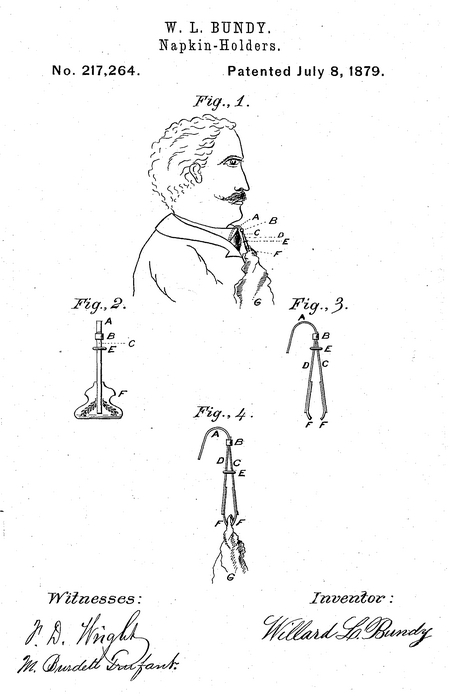
- He was issued patent number 217,264 on 8 Jul 1879
WILLARD L. BUNDY, OF AUBURN, NEW YORK.
IMPROVEMENT IN NAPKIN-HOLDERS.
Specification forming part of Letters Patent No. 217,264, dated July 8, 1879; application filed December 27, 1877.
To all whom it may concern :
Be it known that I, Willard L. Bundy, of the city of Auburn, in the county of Cayuga and State of New York, have invented certain new and useful Improvements in Napkin-Holders; and I hereby declare that the following is a full, clear, and exact description of the same, reference being had to the accompanying drawings, making a part of this specification, in which—
Figure 1 represents the napkin-holder as used to retain a napkin and connected to the collar of a person. Fig. 2 represents a front view of the napkin-holder. Fig. 3 represents a side view of the same with the clamps open. Fig. 4 represents a similar view with the clamps closed and holding a napkin.
My invention relates to devices for retaining a napkin either in a folded form or unfolded and securing it to a person's' garments.
Heretofore napkin-holders have been made with hinged clamping-jaws, forced together by an independent spring or springs, and this kind is generally expensive and liable to get out of order. Others are made to pierce the napkin, and they produce unsightly holes therein; and still others of older form remain in use.
The object of my invention is to produce a device having a hook at one end, a pair of spring griping-arms provided with broad clamps at the other, with an intermediate ring capable of inclosing and sliding upon said arms, and means to retain the ring permanently connected to the device without interfering with its operation, and to allow it to receive a napkin, or any other suitably-sized article, and be retained in form or suspended thereby.
My invention consists in a napkin-holder formed by the combination of two spring-arms provided with enlarged clamps at one end, a hook at the other end, a ring capable of sliding upon the arms, and a clasp to unite said arms and retain the ring permanently connected thereto, as will be hereinafter described.
In the drawings, A represents the hook by which the device may be suspended. 0 and D are the two spring-arms forming the back of the clamps. They are secured together by a sheet-metal clasp, B. The spring-arms may be formed independently of the hook; but to simplify the construction of the device and increase its durability, I prefer to make the hook a continuation of one of the arms, as of the arm C in the present instance.
Each arm has soldered to the lower end thereof a sheet-metal plate, F, of any desired configuration, to enlarge the bearing-surface of the arms 0 and D. Each piece F is bent or formed to present to the other a comparatively sharp edge, to assist in retaining a napkin, G, or other object placed between them.
The arms C and D are made of spring metal, and are so bent and united as to diverge from their point of union at B. Their clamping-plates are brought together by a ring, E, inclosing said arms, and capable of sliding thereon between the inner end of said clamping-plates and the clasp B.
To construct the device, the arms C and D are cut of suitable length of spring metal, the clamps F are stamped of sheet metal and suitably embossed at one operation, and the arms soldered to the latter. (The arms and clamps may be stamped in one piece and suitably corrugated; but this simple mode would be gained by a loss of strength at the place -where the strain is the greatest while the device is in use.) The ring E is then slipped over the arms C and D, clamping them together in position to receive the clasp B, the latter being either soldered or simply forced in position with suitable tools.
The hook A is formed by bending the extremity of the arm C either before or after it is united to the arm D, and the whole device is then silver-plated.
This napkin-holder can be used not only to suspend an unfolded napkin from a person's clothing, but to retain as a napkin-ring said napkin folded after it has been used, the clamp retaining one corner and the hook receiving the central part thereof. It occupies but little room in the pocket, and can be used by travelers to suspend hats, &c, from racks in railroad-cars and in other situations.
Having now fully described my invention, I claim—
In a napkin-holder, the combination of two spring - arms provided with arm - enlarging clamps at one end, a hook at the other end, a ring capable of sliding upon the arms, and a
clasp to unite said arms and retain the ring permanently connected thereto, substantially as and for the purpose described.
Willard L. Bundy
Witnesses:
F. D. Wright
M. Burdett Trufant
- He appeared on the census in 1880 in Auburn NY. Listed as a manufacturing jeweler.

- Example: Tradecard, circa 1880, in Winterthur Library.
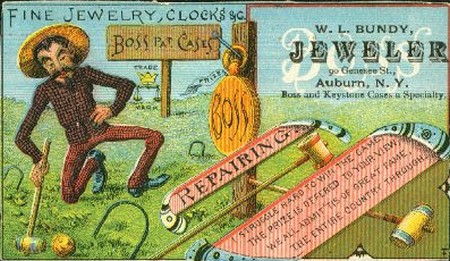
- Example: Tradecard, circa 1880, in Private Collection.
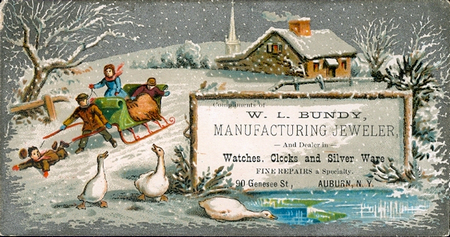
- Example: Tradecard, circa 1880, in Private Collection.
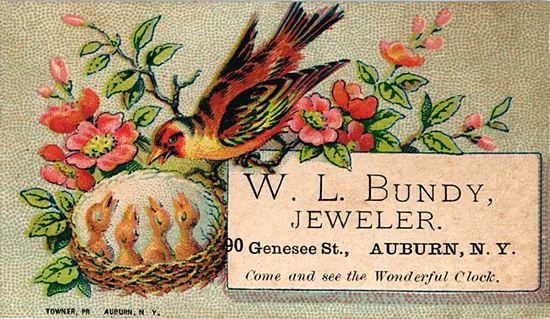
- Example: Tradecard, circa 1880, in Private Collection.
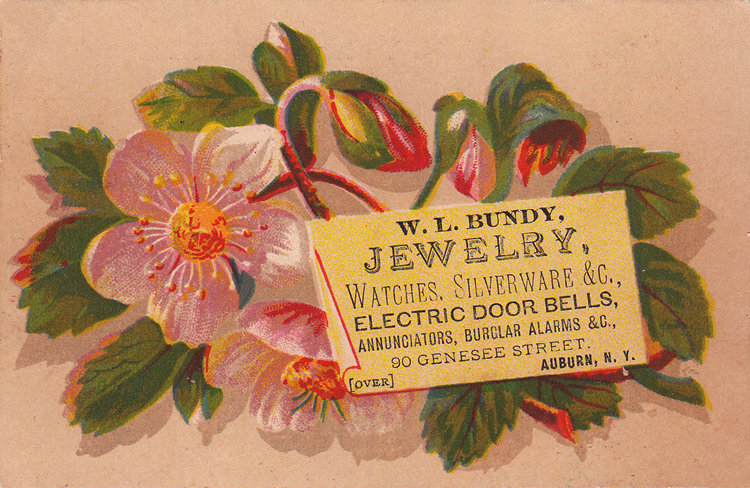
- Example: Tradecard, circa 1880, in Private Collection.
- Partnership: Harlow Elisha Bundy, in 1889, in Binghamton NY. As the Bundy Manufacturing Company, making the first time clocks. This was the beginning of what became, in 1924, International Business Machines Corporation.
|











